15 Purple Perennial Flowers with Pictures + Growing Guides

This post follows our research editorial guidelines.

There are many purple perennials to add to your garden, however, do you know all of them?
With so many options out there, there’s no better time to go over the best perennials you can plant this summer season. A perennial is one that grows for multiple seasons, so if you plant one this summer, you’ll be able to enjoy it again next summer.

While having purple in the garden really wows, you can create an even prettier garden by blending it with complimentary, but contrasting colors, such as orange flowering perennials. This combination will add easy visual interest.
Whether you’re a seasoned gardener or just beginning, these are all easy plants to care for. Here’s a list of the best early and late-blooming purple flowers to plant:
Quickly Find The Purple Flower You’re Looking For:
1. Russian Sage (Perovskia atriplicifolia)
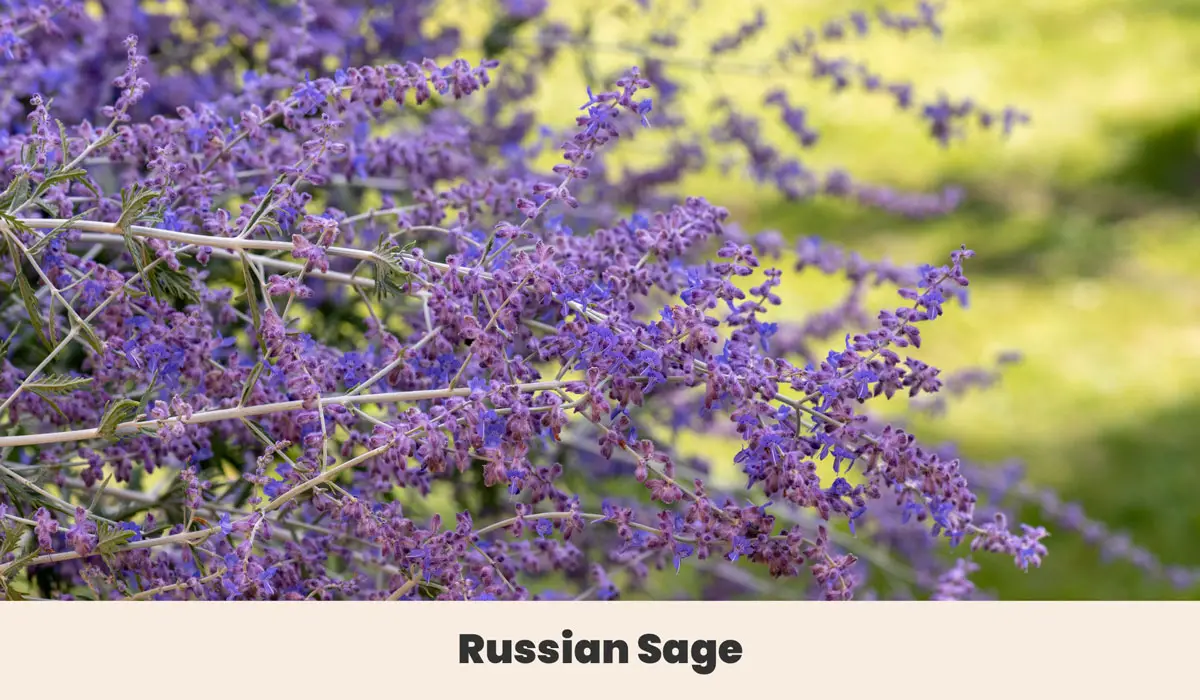
Russian Sage is an excellent option to add to your garden, not only because of how easy it is to care for but because it can grow up to four feet tall, adding a lot of visual interest to your front lawn.
Though this beautiful purple plant does require some watering, you only have to do it while the roots are being established.
Once they are, this purple color flower becomes drought tolerant. Here’s what you need to know about caring for this lavender beauty:
| Botanical Name: | Perovskia atriplicifolia |
| Growth Rate: | Up to 4′ tall |
| Native Range: | Asia |
| Hardiness Zones: | 4-9 |
| Soil Needs: | Well-draining soil that isn’t too rich |
| Exposure: | Full sun |
| Blooming Period: | Summer |
2. Salvia (Salvia nemorosa)

The Salvia plant is a gorgeous addition to anyone’s garden. It’s easy to maintain and provides your garden with a pop of color that can add some visual flare.
One of the reasons why this plant is so easy to maintain is the low amount of water it requires. All you need to do is check to see if the top half-inch of the soil is wet to determine if it needs to be watered. No regular regime is needed.
Here’s more info you need to know to take care of this beautiful plant:
| Botanical Name: | Salvia nemorosa |
| Growth Rate: | Up to 2′ tall |
| Native Range: | Europe and Asia |
| Hardiness Zones: | 4-9 |
| Soil Needs: | Moist, well-draining soil |
| Exposure: | Full sun |
| Blooming Period: | Summer |
3. Phlox (Phlox paniculata)
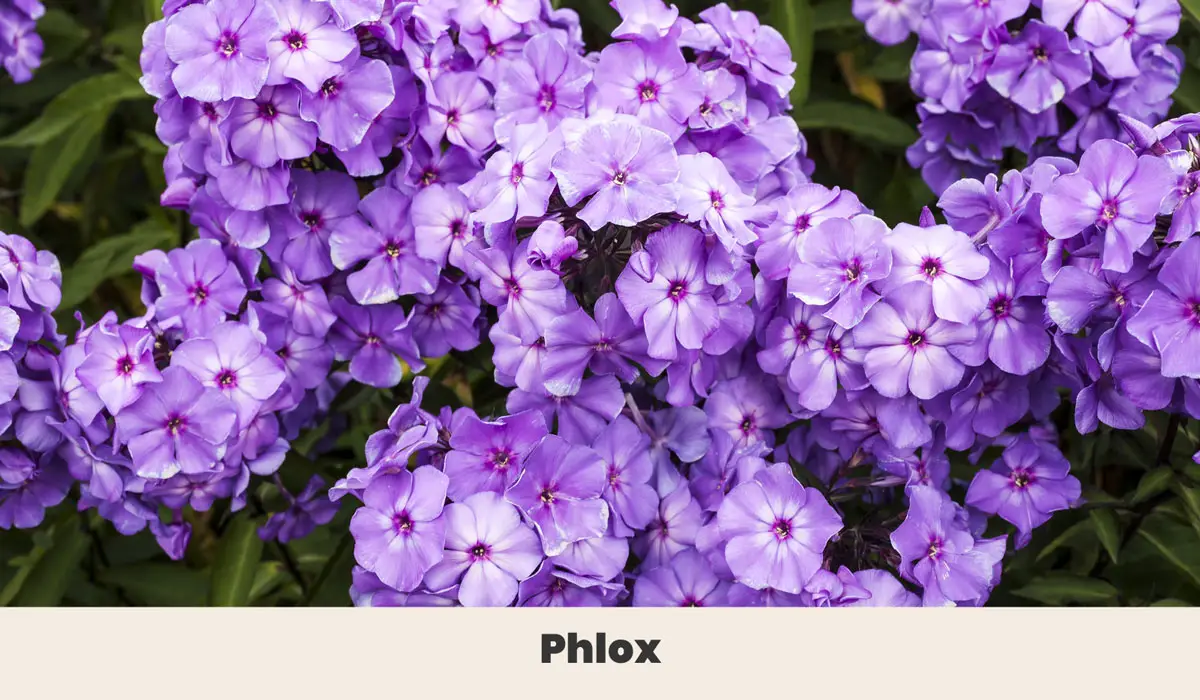
The Phlox is a beautiful flower that stands out in any garden! With its stunning white and pink flowers, it makes a statement while complimenting everything around it.
This flower is also low maintenance, only requiring well-draining soil and water about once a week, making it perfect for beginners. Here’s some more information on how to take care of a Phlox:
| Botanical Name: | Phlox paniculata |
| Growth Rate: | A moist, well-draining soil |
| Native Range: | Up to 4′ tall |
| Hardiness Zones: | 4-8 |
| Soil Needs: | Moist, well-draining soil |
| Exposure: | Full sun or partial sun |
| Blooming Period: | Summer |
4. Veronica (Veronica spicata)

When in bloom, the Veronica plant will either yield gorgeous purple or pink flowers. Veronica plants have pretty spindle-shaped flowers and can grow up to 3 feet tall, making them a real showstopper.
Though you can fertilize this plant, it’s not required. Veronica plants will still bloom beautifully without fertilizer, as long as they’re exposed to the right conditions.
This is a plant that prefers full sun and well-draining soil. Here’s what to know about these beautiful flowers:
| Botanical Name: | Veronica spicata |
| Growth Rate: | Up to 3′ tall and up to 2′ wide |
| Native Range: | Asia and Europe |
| Hardiness Zones: | 3-8 |
| Soil Needs: | Divide the plant in either the spring or fall |
| Exposure: | Full sun |
| Blooming Period: | Summer |
5. Butterfly Bush (Buddleia davidii)

Are you looking for ways to attract more butterflies to your garden? Plant a gorgeous Butterfly Bush!
Aptly named, the Butterfly Bush is great for attracting pollinators to your garden. While it’s common to see this plant display deep purple flowers, you may also get white blossoms.
Keep in mind that this plant grows best when it has fertilizer in the spring and early summer. However, do not apply fertilizer any later than July as this could create issues with the plant’s ability to lay dormant for the fall and winter seasons.
Interested in adding some purple and white flowers to your garden? Here’s what you need to know about caring for the popular Butterfly Bush!
| Botanical Name: | Buddleia davidii |
| Growth Rate: | Up to 10′ tall and up to 10′ wide |
| Native Range: | China |
| Hardiness Zones: | 6-9 |
| Soil Needs: | Well-draining soil with organic matter |
| Exposure: | Full sun |
| Blooming Period: | Summer – early fall |
6. Bee Balm (Monarda didyma)

Bee Balm is just such a fun name, isn’t it? Aside from its cute name, the Bee Balm plant also has gorgeous flowers that are a shade in between dark purple and red.
The Bee Balm plant does best when grown in either full sun or partial shade. It is a native perennial to North America, including both Canada and the United States. You can expect it to bloom all summer long, mainly through July and August.
Here’s a handy care guide for these flowers that bloom in the summer:
| Botanical Name: | Monarda didyma |
| Growth Rate: | Up to 4′ tall |
| Native Range: | United States and Canada |
| Hardiness Zones: | 4-9 |
| Soil Needs: | Rich, well-draining loam |
| Exposure: | Partial shade to full sun |
| Blooming Period: | Summer |
| Water needs: | Water to keep the soil consistently moist |
7. Balloon Flower (Platycodon grandiflorus)

Balloon Flowers have a blue and purple hue to them. These small star-shaped flowers are easy to grow and highly resistant to disease as long as they have the right conditions to grow.
For example, the Balloon Flower will bloom best when exposed to full fun and organic, well-draining soil.
Taking care of these purple blooms is easy with this care guide:
| Botanical Name: | Platycodon grandiflorus |
| Growth Rate: | Up to 30″ tall and up to 18″ wide |
| Native Range: | Japan, China, and Siberia |
| Hardiness Zones: | 3-8 |
| Soil Needs: | Divide the plant in the spring |
| Exposure: | An organic, well-draining soil |
| Blooming Period: | Summer |
8. Meadow Rue (Thalictrum)

Meadow Rue is easily one of the prettiest light purple flowers on this list. Growing anywhere between 4 feet and 6 feet tall, this late-summer flowering plant adds visual interest to any landscape. It has small pinkish-purple flowers and grows best in full sun.
Keep in mind that because of how thin Meadow Rue is, you may need to stake it so it can take shape and grow easily.
Here’s everything you need to know about this beautiful perennial that blooms from mid-to-late summer:
| Botanical Name: | A moist, well-draining soil |
| Growth Rate: | Up to 6′ tall and up to 3′ wide |
| Native Range: | United States |
| Hardiness Zones: | 3-8 |
| Soil Needs: | Moist, well-draining soil |
| Exposure: | Full sun or partial shade |
| Blooming Period: | Summer |
9. Foxglove Beardtongue (Penstemon digitalis)
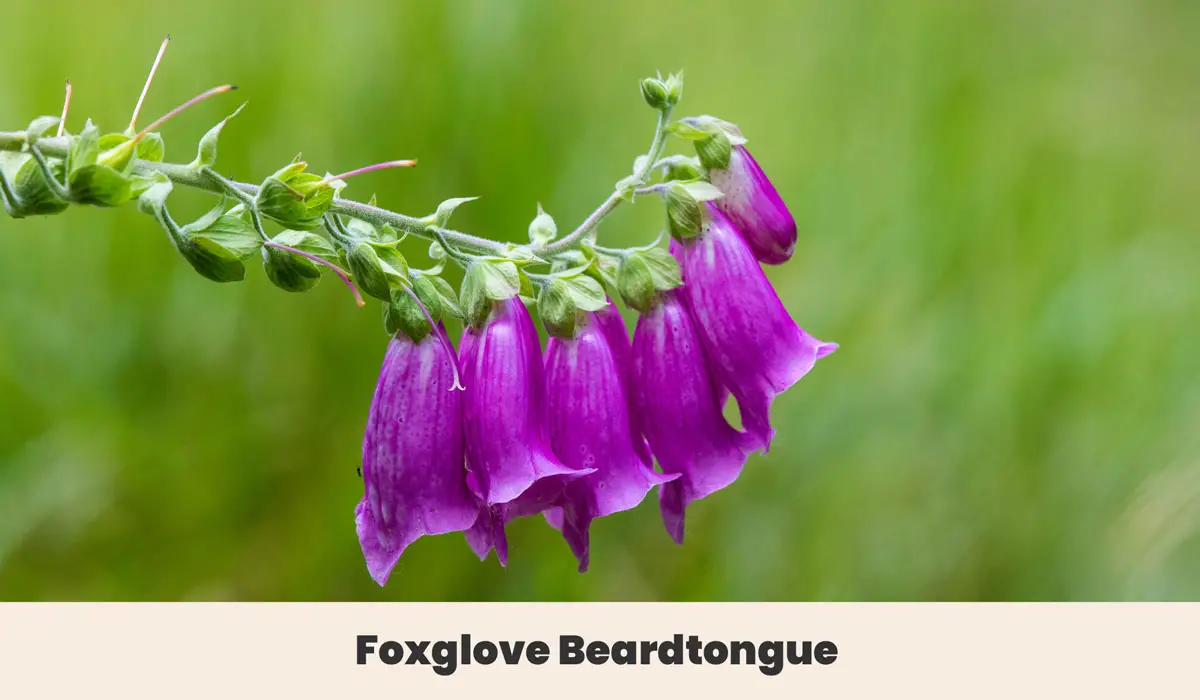
Though you’re likely to see Foxglove Beardtongue plants develop white and even red flowers, they do come in purple varieties, too.
These dark purple flowers get their name from their unique, cone-like shape, with the stamen resembling a tongue.
Aside from being easy to care for, Foxglove Beardtongue plants are one of my favorite purple perennials because they adapt to many types of soil, attract pollinators, and can go long periods without water. It’s the perfect plant for beginners.
If you want to know more about my favorite purple perennial flowers, check out the helpful guide below:
| Botanical Name: | Penstemon digitalis |
| Growth Rate: | Up to 48″ tall |
| Native Range: | United States |
| Hardiness Zones: | 3-8 |
| Soil Needs: | Rich well-draining soil with a slightly acidic pH |
| Exposure: | Full sun and partial shade |
| Blooming Period: | Spring-early summer |
10. Anise Hyssop (Agastache foeniculum)

When in bloom, the Anise Hyssop develops small flowers in various shades including purple, pink, and orange. Though they are not super susceptible to pests, they can fall victim to common plant diseases such as root rot if they have too much water.
The Anise Hyssop likes moist soil, but not wet or soggy soil, so try to avoid overwatering. These also make excellent cut flowers to add to a bouquet, so feel free to cut them down and bring them inside.
Here’s what you need to know about this beautiful purple perennial:
| Botanical Name: | Agastache foeniculum |
| Growth Rate: | Up to 4′ tall |
| Native Range: | North America |
| Hardiness Zones: | 4-8 |
| Soil Needs: | Dry or moist, well-draining soil |
| Exposure: | Full sun |
| Blooming Period: | Summer |
11. Columbine (Aquilegia)

The Columbine plant is a striking flower with petals a deep shade of purple and bright white centers.
In fact, this plant has flowers that look the opposite of what you’d normally expect, making them the perfect perennial flowering plant to add to your garden for visual interest.
Either full sun or partial shade is required for this perennial to grow. However, your flowers may start to wilt if they’re exposed to consistent heat, so try to plant them in an area that does get a little bit of natural shade covering.
Best of all, once established, they are extremely drought-tolerant, making them ideal for any homeowner who lives out west.
Here’s what you need to know about this large perennial with purple flowers:
| Botanical Name: | Aquilegia |
| Growth Rate: | Up to 3′ tall and up to 2′ wide |
| Native Range: | Asia, North America, and Europe |
| Hardiness Zones: | 3-9 |
| Soil Needs: | Moist, well-draining soil |
| Blooming Period: | Spring – Summer |
12. Lupine (Lupinus polyphyllus)
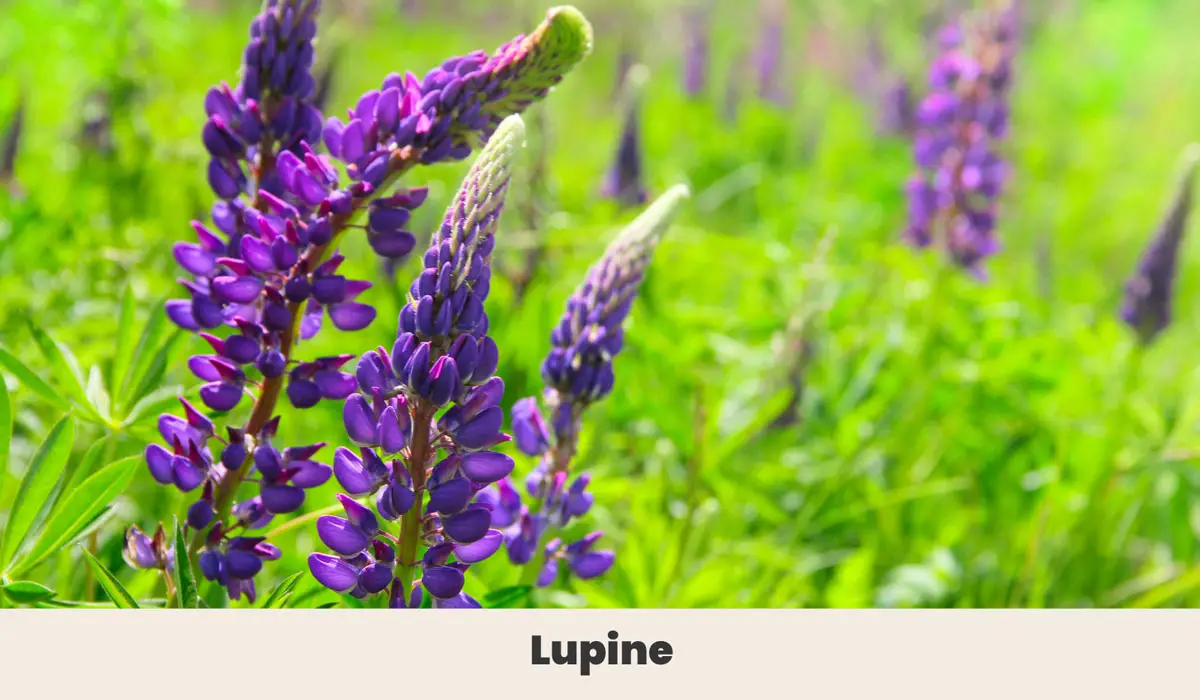
Why should you add these tall spires of flowers to your garden? Aside from creating visual interest, these pale purple flowers are easy to care for.
This herbaceous perennial can grow up to 4.9 feet tall. This North American native plant thrives best in full sun.
Here’s how to care for this flowering perennial that blooms from late spring to early summer:
| Botanical Name: | Lupinus polyphyllus |
| Growth Rate: | Up to 4.9′ tall |
| Native Range: | North America |
| Hardiness Zones: | 3-6 |
| Soil Needs: | Well-draining soil |
| Exposure: | Full sun |
| Blooming Period: | Late spring – early summer |
13. German Iris (Iris germanica)
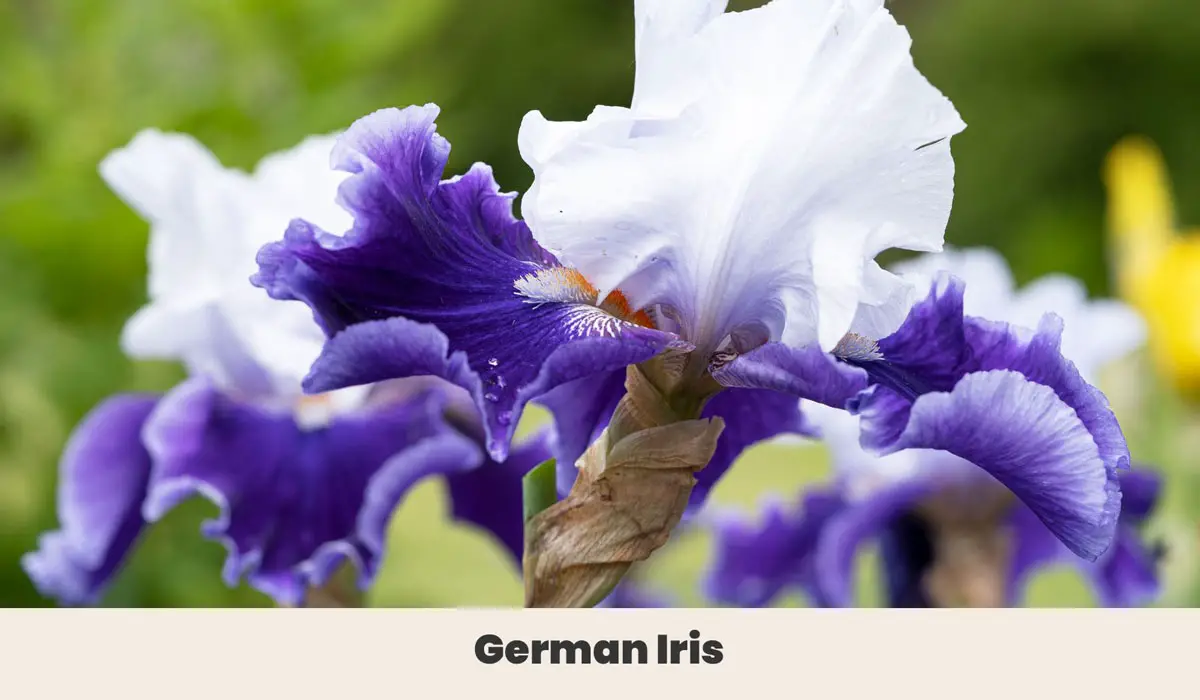
The most important thing to remember about growing the beautiful German Iris is that, even though it can thrive with full sun to partial shade, it will usually do best in full sun.
This gorgeous purple perennial is more resistant to diseases when growing in full sun. Here’s how you can take care of this plant that will grow between 2 to 3 feet tall:
| Botanical Name: | Iris germanica |
| Growth Rate: | Up to 3′ tall |
| Native Range: | The Mediterranean |
| Hardiness Zones: | Divide the plant every 3-4 years in the summer |
| Soil Needs: | Moist, well-draining soil with organic matter |
| Exposure: | Full sun |
| Blooming Period: | Spring |
14. Chinese Astilbe (Astilbe chinensis)
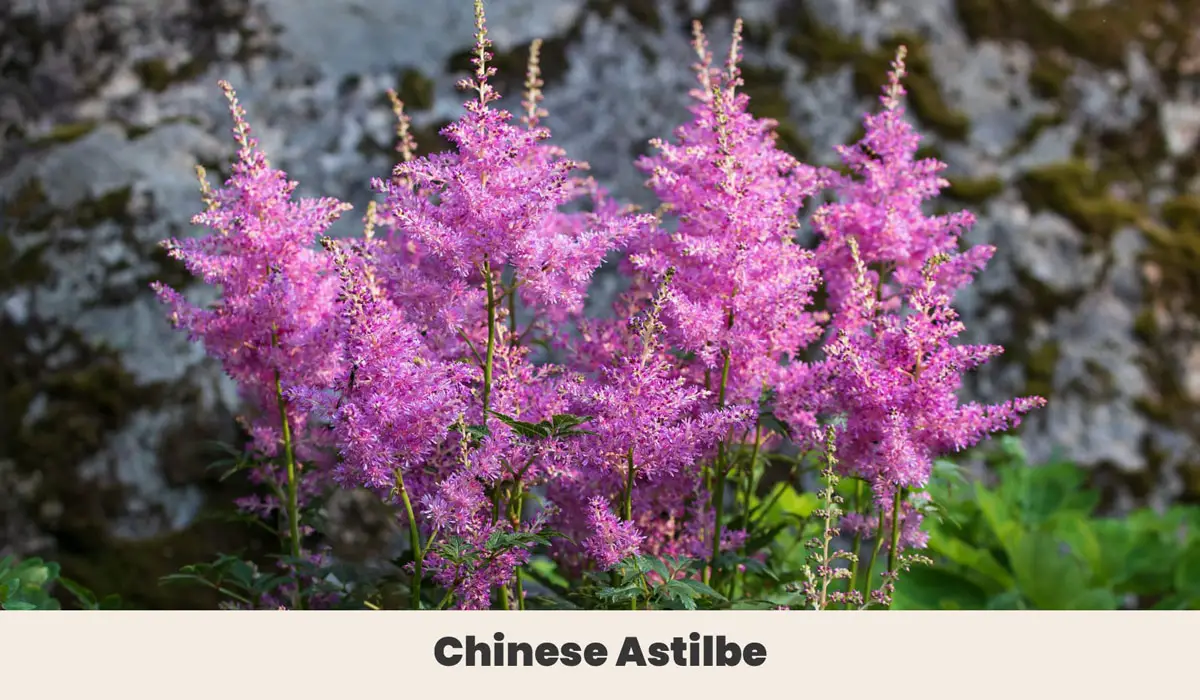
If you’re looking for pink and purple perennials to add to your garden, look no further than the Chinese Astilbe.
The Chinese Astilbe plant is very easy to care for. Not only does it add a splash of purple to your garden, but it is also a great option if you have children since their plumes resemble fluffy bright feathers.
| Botanical Name: | Astilbe chinensis |
| Growth Rate: | Up to 16′ tall |
| Native Range: | North America |
| Hardiness Zones: | A moist, well-draining soil |
| Soil Needs: | Moist, well-draining soil |
| Exposure: | Partial shade |
| Blooming Period: | Summer |
| Water needs: | Once roots are established, water once a week |
15. Blazing Star (Liatris spicata)
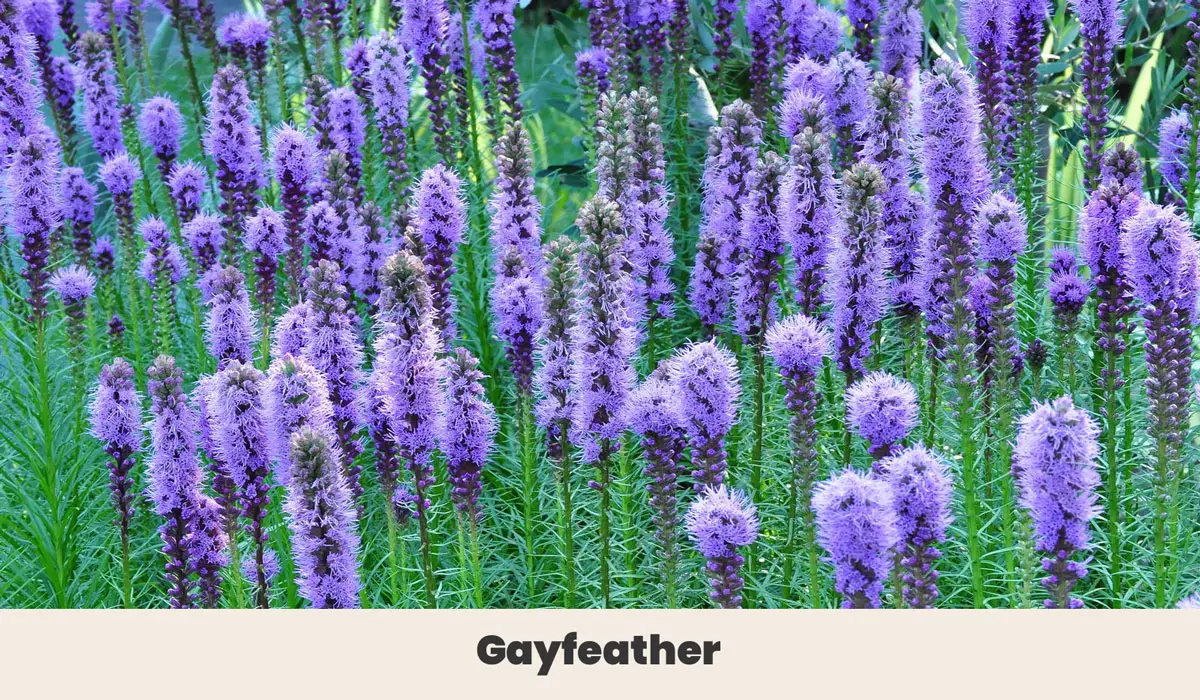
Whether you call it Gayfeather or a Blazing Star, one thing’s for sure: this plant draws visual interest! Growing up to six feet tall, the Gayfeather plant has tall spiky blooms that have a pretty cool texture.
In addition to this, they are very slender, so they’re perfect for lining the back of your garden and mixing with all the other flowers you have planted.
This plant can easily adapt to any type of soil, though it does prefer soil that is well-draining to avoid root disease. Furthermore, because of how tall and thin they are, you might want to stake it.
| Botanical Name: | Liatris spicata |
| Growth Rate: | Up to 6′ tall |
| Native Range: | North America |
| Hardiness Zones: | 3-9 |
| Soil Needs: | Well-draining soil |
| Exposure: | Full sun |
| Blooming Period: | Early to mid-summer |
Before You Go!
So there you have it: the best ways of using purple flowers in your garden. Everything mentioned on this list is a perennial that blooms all summer, so you’ll have plenty of chances to enjoy it not only this year but next year, too.
I’ve curated a list of related posts I think you might like:
Whether you’re looking for ground cover or blue or purple flowers that will attract pollinators, these are the best plants to try out. This guide can help you care for them.
As always if you have something to share, drop a comment and let me know! I’ll make sure to get back to all your questions and suggestions. Have a great day. 😊

Before you go!
11 Weeds With White Flowers + Pictures and Growing Guides (Common Weeds with White Flowers)
11 Plants With Year-Round Flowers – Enjoy Gardening in Full Bloom
10 Flowers I’ve Found That Look Like Butterflies
12 Tall Perennials With The Best Pink Flowers in Bloom